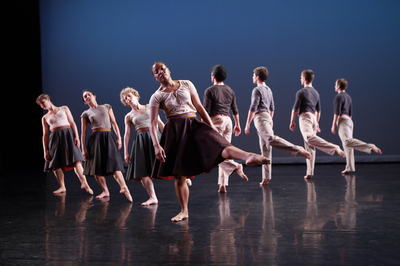Mark Morris Dance Group presents rich, rewarding program at Power Center

Mark Morris Dance Group publicity photo
photo by Richard Termine
The company appears again tonight in a program identical to Friday’s, and it would hardly be surprising to see repeat viewers in the audience, so rewarding is the triple bill of Morris’s “Excursions,” “Festival Dance” and “Socrates.” Choreographically, musically, scenically these dances reward the viewer immensely.
And the viewer is, Morris never lets us forget, also a listener. The musicians Morris works with—like pianist Colin Fowler, a star in all three works Friday evening—are as extraordinary and as communicative as his ever-wonderful troupe of dancers.
The intersection of music and dance is particularly fascinating in “Socrates,” Morris’s 2010 work set to Satie’s “Socrate,” sung affectingly Friday by baritone Michael Kelly with Fowler at the piano.
The music is spare and elegant, cool and removed (and the more affecting for it) even at its narrative apogee in the “Death of Socrates” section. Morris and his stage collaborators, costume designer Martin Pakledinaz and lighting and scenic designer Michael Chybowski, respond with equal reserve: classical groupings and “simple” steps; taupe, sky and earth-tone togas for the dancers, a black and white backdrop.
In the first section, the dancers are joined, in twos and sometimes threes, by chains that link their hands and suggest the eventual imprisonment of the dance’s hero. The second section, “The Banks of the Ilissus” is a choreographic idyll, with the dancers crossing the stage in friezelike processions. In the final section, Morris constantly divides his forces into three groups of five. He works marvelous counterpoint among them, and then, as the text takes us to Socrates’ final moments, he has them represent the narrative in gesture and pose, taking us, via a stage filled with felled dancers, to Socrates’ mortal end.
And yet, where is Socrates? The “hero” is in many respects not on the stage at all, but in the pit: Kelly, singing Satie’s music and Plato’s words. He is like a dance soloist, and the dancers are like a chorus, sometimes representing an underlying musical idea and sometimes the text. It’s a remarkable exchange of roles.
“Socrates” closed the program on a high plane, but playfulness was more the order of business in the first half of the program.
Morris’s 2008 “Excursions,” set to Samuel Barber’s piano score—which he uses in reverse, counting down from Section IV—was the delighful opener. It a game of a dance for six (Rita Donahue, Laurel Lynch, Dallas McMurray, William Smith III, Noah Vinson and Michelle Yard) that constantly makes you wonder what the next move will be.
It takes its cues—visually and choreographically—from Barber’s Americana. The opening movement’s a sort of twist-cum-hoedown—and look: There’s the square on the floor to contain the dancers’ do-si-dos and a red sky behind with a string of lights to frame it. Are they in the box or outside it? That’s the question later movements ask, and the answers are imaginative and neatly shaded.
“Festival Dance,” which Morris debuted last year, doubles the number of dancers—and the fun. Set to the unlikely and, in this case, deliciously seductive music of Johann Nepomuk Hummel (his 5th piano trio, played by Fowler, violinist Michi Wiancko, and cellist Wolfram Koessel), it’s one of Morris’s most joyous, generous and open dances, brimming with community, good will and good nature.
The musical material—a waltz , a march and a polka (a rondo polka, no less)—is a dazzling ground for Morris’s own virtuosic imagination. Motifs from one movement—from waltz steps to a gesture of blessing as a pair of dancers move down the line, arms joined and raised over the heads of their fellow dancers—reoccur to create a grand, sociable structure. Morris has his dancers feint charmingly—bouncy one moment, wilted the next—just as Hummel does as he delays the final cadence of the final movement. When the dance closes with a couple embracing, just as it began, it makes you catch your breath—you don’t see it coming. But just maybe, somewhere deep inside, you heard it.
The Mark Morris Dance Group performs again at 8 tonight. Tickets: ums.org

